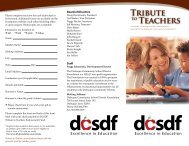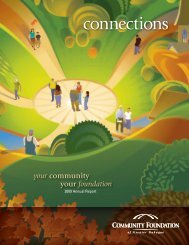Download the Community Solutions Action Plan Executive Summary.
Download the Community Solutions Action Plan Executive Summary.
Download the Community Solutions Action Plan Executive Summary.
Create successful ePaper yourself
Turn your PDF publications into a flip-book with our unique Google optimized e-Paper software.
The Problem<br />
The biggest challenge facing our community is disproportionate achievement rates of minority students and students in<br />
poverty. While overall our students are achieving at a high level, a disproportionate rate of minority students are entitled<br />
to Special Education services: 11.45% black, 2.37% Hispanic, and 2.72% multi-racial in 2011-12. Whe<strong>the</strong>r we look at<br />
reading achievement, school attendance, or school readiness, <strong>the</strong> story is <strong>the</strong> same.<br />
In addition, while many Dubuque students demonstrate success in 3rd Grade Reading Achievement based on <strong>the</strong> Basic<br />
Reading Inventory, of <strong>the</strong> 14% of students not meeting 3rd grade reading targets, half (7%) are entitled. The remaining 3rd<br />
grade students are overwhelmingly black, male and receive free and reduced lunch services.<br />
Dubuque students arrive at kindergarten ready to learn and data shows our four-year old preschool is a major<br />
factor in driving <strong>the</strong>se school readiness rates. However, <strong>the</strong> program is at risk due to state funding challenges and a<br />
disproportionate number of students from at-risk populations are still not school-ready by age 5.<br />
Similarly, while <strong>the</strong> Average Daily Attendance (ADA) rate in our schools is 95%, <strong>the</strong> opportunity remains to reach <strong>the</strong> most<br />
at-risk students who are not attending at rates that promote achievement. We need to improve our attendance data.<br />
Improving summer learning opportunities may be our community’s most significant opportunity. While we have an<br />
abundance of summer activities for our young people, <strong>the</strong>re is little coordination among <strong>the</strong>se activities and a significant<br />
need to incorporate learning opportunities into <strong>the</strong>se programs to support <strong>the</strong> school curriculum.<br />
We can also impact each of <strong>the</strong>se challenges with broader strategies including improved coordination of efforts and<br />
resources, and aligning provided and proposed services with a Collective Impact model.<br />
Finally, we must consider how our policies can better ensure:<br />
• More proportionate density of poverty and minorities within schools<br />
• Improved access to summer learning opportunities for all young people<br />
• An engaged health community that provides lead-testing and wellness care<br />
• High attendance standards for kindergarten and four-year-old preschool<br />
• Employer awareness of how policies affect parents’ abilities to support children<br />
• Issues like attendance are addressed in community-based organization programming<br />
• School attendance policies are fair and consistently enforced district-wide.<br />
Our goal is to find models to help impact <strong>the</strong> most vulnerable students while building on current success. We will build on<br />
our strong history of partnerships, collaboration, and innovation to move our 3rd Grade Reading Achievement from good<br />
to great.<br />
3rd Grade Reading <strong>Community</strong> <strong>Solutions</strong> <strong>Action</strong> <strong>Plan</strong> <strong>Executive</strong> <strong>Summary</strong> | Dubuque, Iowa | Page 2







